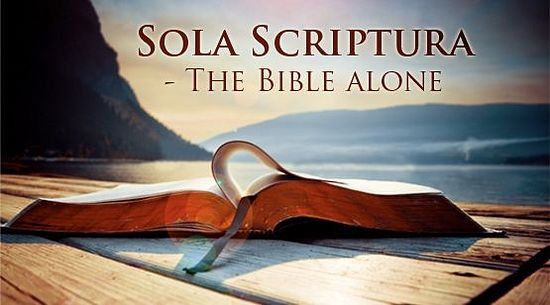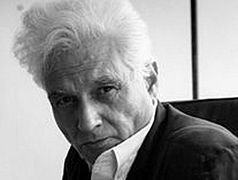Most Evangelical Protestants do not have a great love for Latin (people of my vintage can remember when Latin was inevitably associated in Evangelical minds with the horrible benighted Catholics, who used Latin as their liturgical language), but there are two Latin words very close to their hearts: “sola Scriptura”, which is Latin for “Scripture alone”. Those dipping a little into Reformation history will recall that it shared the stage with a few other Latin slogans, such as “sola fide” (faith alone), “sola gratia” (grace alone), and “solus Christus” (Christ alone). The words formed something like a banner, a code for the entire Reformed package—and sometimes a war-cry shouted when going into ideological battle.
The phrase “sola Scriptura” at the time of the Reformation didn’t mean that the Protestants waving that banner had no time for tradition, the Fathers, or learning. Reformers like Luther and Calvin were happy to quote the Fathers (Augustine was a favourite), especially when the Fathers seem to agree with them. In the medieval western church, there were two ways of establishing a doctrine—Scripture and Tradition. The Roman Catholic Council of Trent would eventually define that the truth of the Gospel was accessed by the twin means of Scripture and Tradition. The final decree read, “This truth and rule are contained in written books and in unwritten traditions.” The two realities—Scripture and Tradition—are clearly distinct one from another, and either one may be used to establish a doctrine or a practice. The Reformers were concerned not to jettison Tradition altogether, but to subordinate it to Scripture. The Reformers did not deny that the Fathers had a role in interpreting the Scriptures. They just said that the Fathers’ views could not be binding or authoritative. What they were taking aim at was not so much the ancient Fathers as the contemporary Catholic magisterium—and the Pope in particular, its leading representative.
The Reformers of course produced their own magisterial statements of faith. The Reformation ground out a good many of them: the Lutheran Schmalkald Articles, the Book of Concord, the Reformed Helvetic Confessions, the Belgic Confession, the Heidelberg Catechism, the Presbyterian Westminster Confession, and the Anglican Thirty-Nine Articles. But despite such an outpouring of magisterial teaching, the Reformers were clear that these confessions had a distinctly secondary and subordinate role. They were not to be considered as authoritative sources of doctrine, but simply as reliable summaries of the truths of Scripture. Scripture alone was the sole authoritative source of doctrine. And it was thought that the main saving message of Scripture was clear enough to be understood by all who approached it humbly and with reliance upon God. There were parts of the Scripture that were less clear, of course, but the main message of salvation was clearly set forth. The Church’s task was to proclaim this message and to order the life of its members. “Sola Scriptura” did not mean that Tradition was worthless, and it did not mean that an individual Christian could do without the Church so long as he had his Bible.
Now however, among most Evangelical Protestants, the phrase “sola Scriptura” has come to mean something rather different—and something that their Reformed ancestors would not have been happy with. Now the phrase means not so much “Scripture above Tradition” but rather “Scripture and no Tradition”. The modern idea is that Tradition is bad, and that all a pious heart needs to understand the Bible is an open mind and a good intention, and the Holy Spirit will do the rest. The Lord’s promise that the Spirit will lead His Church into all truth (John 16:13) is interpreted to mean that the Holy Spirit will lead every individual believer into all truth, so that the Bible alone is sufficient, and that everything in the Bible can be immediately and easily understood.
In this regard one sometimes hears (rather inane) slogans such as “My only Creed is the Bible”, which is a bit like saying, “My only Creed is the theological library”, since the Bible is not a single volume, but a collected library of over sixty-six books. One cannot easily translate the meaning of a whole library’s worth of books into a tidy theological system, for the multiplicity of books allows for a multiplicity of possible meanings. Something outside the Biblical library must function as a lens through which the books are read if one is to find a single coherent meaning of it all.
Nonetheless, Evangelicals persist in saying that the single integrated message of all the sixty-six books of the Bible is plain to all impartial readers, and that nothing else is required to interpret it correctly. I remember one such Evangelical author, Harold Hill, in his book How to Live Like a King’s Kid, refer to the Bible as “the manufacturer’s handbook”. In this view the Bible functions like a divine set of Ikea assembly instructions—all one needs to assemble a church and a Christian life is the Bible. No other sets of instructions are necessary. This view is sometimes expressed in terms of warm piety, as when a Christian man is described as “a man of one Book”. The man reads the Bible and only the Bible and is able unaided to understand its main message, since the meaning of that message is abundantly self-evident. Sometimes this piety takes the added step of despising theological education, rejecting it as an obstacle to understanding the Bible, as a source of confusion which can only befuddle simple souls. Sometimes this piety even sets the individual Christian against the Church, and declares that the Church has no role in interpreting the Bible at all. The man of one Book can understand the Bible on his own, thank you very much, so why does he need a church or a pastor to tell him what it means? He can read it for himself just fine.
There are two problems with this understanding of “sola Scriptura”, even if one omits the grosser errors of rejecting theological education and of rejecting any role for Church or pastor.
First of all, it is crystal clear that the main message of salvation in the Bible is not self-evident, and that is why there are literally thousands of Protestant denominations, all reading the same Bible and all coming up with differing interpretations of it. And these interpretations sometimes differ about fairly basic things. Take the basic question, “What must I do to be saved?” Does becoming saved have anything to do with baptism? Does baptism save and regenerate? Who can be baptized—adults and babies, or just adults? Intelligent devout Christians disagree about this basic question, though all read the same Bible. Or take the equally basic question, “What does the Church do when it meets together?” Should it meet on Sunday or Saturday? Is the Eucharist to be celebrated every week? And what is the Eucharist? Is it a sacrifice? In it do we receive Christ’s true Body and Blood? May infants receive the Eucharist? Intelligent devout Christians disagree about this question as well. Other important questions remain too. May we pray for the dead? May we pray to the saints? Are we to face a particular direction when we pray? Is separation from a church to form a church of your own (i.e. schism) allowable? These are not side-issues of insignificance. The question of how one becomes a Christian, how one worships God every week, and to whom and for what one may pray constitutes the main message of the Bible, and it is precisely here that violent disagreements are to be found.
The confusion that reigns in answering these questions reveal that the Bible is not self-interpreting, but that a lens is required through which we read the Scriptures. Orthodoxy says that the required lens is found in the consensus patrum, the broad agreement found in all the Fathers. And regardless of what the magisterial Reformers said about the subordinate place of their confessions, it seems clear that these confessions actually functioned in the same way for them as the consensus patrum functions for the Orthodox. Devout Presbyterian teens do not believe in the Limited Atonement because they see that it is self-evident in the Bible, but because the Westminster Confession tells them that Christ died only for the elect. Even the Evangelicals have recourse to a lens of sorts—witness the popularity of Study Bibles, including the famous (or infamous) Scofield Reference Bible with its dispensational notes. The message of the Bible only seems self-evident to those raised in it from their youth, because they have been reading the teaching of their confessions into it. Note: what those confessions teach may or may not be true. But even if it is true, it is not self-evident. The problem with “sola Scriptura” is that for the Scriptura to be understood, it can never be sola. A lens is required to understand it.
St. Vincent of Lerins pointed this out long ago when he wrote, “It may be, someone will ask, Since the canon of Scripture is complete, and is in itself abundantly sufficient, what need is there to join to it the interpretation of the Church? The answer is that because of the very depth of Scripture all men do not place one identical interpretation upon it. The statements of the same writer are explained by different men in different ways, so much so that it seems almost possible to extract from it as many opinions as there are men…Therefore, because of the intricacies of error, which is so multiform, there is great need for the laying down of a rule for the exposition of Prophets and Apostles in accordance with the standard of the interpretation of the Catholic Church.” This “rule” is the consensus patrum, also known as Holy Tradition.
Secondly, when one looks into the Scriptures one sees that the apostles themselves refer to oral traditions as a source of equal authority. Thus St. Paul writes in 1 Corinthians 11:2, “I commend you because you remember me in everything and maintain the traditions even as I have delivered them to you”. Or again in 2 Thessalonians 2:15, where he writes, “So then, brethren, stand firm and hold to the traditions which you were taught by us, either by word of mouth or by letter”. What possessed authority was the teaching of the apostles, and it was irrelevant whether it transmitted orally (i.e. “by word of mouth”, oral tradition) or in writing (i.e. by letter, the epistles of the New Testament). Authority resided in apostolic Tradition, however transmitted. Paul’s epistles were not authoritative because God had turned on an inspiration switch before Paul wrote and then turned if off again when he finished writing. They were authoritative because Paul was an apostle—as he vigorously insisted. St. Basil knew that authority lay in apostolic teaching however transmitted, and that was why he wrote, “Concerning the teachings of the Church, whether publicly proclaimed or reserved to members of the household of faith, we have received some from written sources, while others have been given to us secretly, through apostolic tradition. Both sources have equal force in true religion. No one would deny either source—no one, at any rate, who is even slightly familiar with the ordinances of the Church” (from his On the Holy Spirit).
One therefore cannot legitimately sunder Scripture from the rest of Tradition, or speak of “Scripture and Tradition” as separate things as the West does. Scripture is a part of the capital ‘T’ apostolic Tradition, and one can no more speak of “Scripture vs. Tradition” than one can speak of “the New Testament vs. the Bible”. Scripture reigns supreme in the Church, but it is never sundered from oral tradition and is read as a part of the total Tradition. It is because this apostolic Tradition is supreme in the Church that the Church is the only authorized interpreter of Scripture. That is why St. Paul declares that “the pillar and bulwark of the truth” is not the Bible, but the Church (1 Timothy 3:15).
All Christian confessions read Scripture and do their best to be faithful to it. And every confession has some lens through which it reads the Bible and makes its interpretations. The ultimate problem with Sola Scriptura as defined by modern Evangelicals is that it serves to blind them to the fact that they too use an interpretive lens. And they will never be able to critique that lens and perhaps choose a different one until they admit in the first place that they have one.





